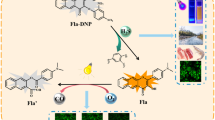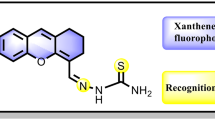Abstract
A novel flavonol-based fluorescent probe, Fla-DNT, has been synthesized for the rapid and specific detection of H2S. Fla-DNT exhibits excellent selectivity and anti-interference properties, a short response time (4 min), large Stokes shift (138 nm), and low detection limit (1.357 µM). Upon exposure to H2S, Fla-DNT displays a remarkable increase in fluorescence intensity at 542 nm. Meanwhile, the recognizing site of H2S was predicted through Electrostatic potential and ADCH charges calculations, while the sensing mechanism of H2S was determined via HRMS analysis and DFT calculation. More importantly, the probe owes multiple applications, such as a recovery rate ranging from 92.00 to 102.10% for detecting H2S in water samples, and it can be fabricated into fluorescent strips to track H2S production during food spoilage by tracking color changes, thereby enabling real-time monitoring of food freshness. The bioimaging experiments demonstrate the capability of Fla-DNT to detect both endogenous and exogenous H2S in living cells. These results provide a reliable method and idea for H2S detection in complex environments.









Similar content being viewed by others
Data Availability
The data generated and analyzed will be made available upon reasonable request from the corresponding authors.
References
Li L, Rose P, Moore P (2011) Hydrogen sulfide and cell signaling. Annu Rev Pharmacol 51:169–187
Wang R (2002) Two’s company, three’s a crowd: can H2S be the third endogenous gaseous transmitter? Faseb J 16:1792–1798
Li L, Moore P (2008) Putative biological roles of hydrogen sulfide in health and disease: a breath of not so fresh air? Trends Pharmacol Sci 29:84–90
Koskela J, Sarfraz J, Ihalainen P, Määttänen A, Pulkkinen P, Tenhu H, Nieminen T, Kilpelä A, Peltonen J (2015) Monitoring the quality of raw poultry by detecting hydrogen sulfide with printed sensors. Sens Actuators B Chem 218:89–96
Yang X, Lu X, Wang J, ,Wang J, Zhang Z, Du X, Zhang J, Wang J (2022) Near-Infrared fluorescent probe with a large Stokes Shift for detection of Hydrogen Sulfide in Food Spoilage, living cells, and zebrafish. J Agric Food Chem 70:3047–3055
Muthusamy S, Rajalakshmi K, Zhu D, Zhao L, Wang S, Zhu W (2020) A novel lysosome targeted fluorophore for H2S sensing: enhancing the quantitative detection with successive reaction sites. Sens Actuators B Chem 320:128433–128440
Xiao P, Liu J, Wang Z, Tao F, Yang L, Yuan G, Sun W, Zhang X (2021) A color turnon fluorescent probe for real-time detection of hydrogen sulfide and identification of food spoilage. Chem Commun 57:5012–5015
Wing S, Wolf S (2000) Intensive livestock operations, health, and quality of life among eastern North Carolina residents. Environ Health Persp 108:233–238
Muthusamy S, Rajalakshmi K, Zhu D, Zhao L, Wang S, Zhu W (2020) A novel lysosome targeted fluorophore for H2S sensing: enhancing the quantitative detection with successive reaction sites. Sens Actuators B Chem 320:128433
Szabo C (2007) Hydrogen sulphide and its therapeutic potential. Nat Rev Drug Discov 6:917–935
Chen S, Li H, Hou P (2018) A novel imidazo[1,5-α]pyridine-based fluorescent probe with a large Stokes shift for imaging hydrogen sulfide. Sens Actuators B Chem 256:1086–1092
Skovgaard N, Gouliaev A, Aalling M, Simonsen U (2011) The role of endogenous H2S in cardiovascular physiology. Curr Pharmaceut Biotechnol 12:1385–1393
Luo W, Xue H, Ma J, Wang L, Liu W (2019) Molecular engineering of a colorimetric two-photon fluorescent probe for visualizing H2S level in lysosome and tumor. Anal Chim Acta 1077:273–280
Lee M, Schwab C, Yu S, McGeer E, McGeer P (2009) Astrocytes produce the antiinflammatory and neuroprotective agent hydrogen sulphide. Neurobiol Aging 30:1523–1534
Choi M, Cho M, Ryu H, Hong J, Chang S (2017) Fluorescence signaling of thiophenol by hydrolysis of dinitrobenzenesulfonamide of 2-(2-aminophenyl) benzothiazole. Dyes Pigm 143:123–128
Wang N, Wang H, Zhang J, Ji X, Su H, Liu J, Wang J, Zhao W (2022) Diketopyrrolopyrrole-based sensor for over-expressed peroxynitrite in drug-induced hepatotoxicity via ratiometric fluorescence imaging. Sens Actuators B Chem 352:130992
Fan G, Wang N, Zhang J, Ji X, Qin S, Tao Y, Zhao W (2022) BODIPY-based near-infrared fluorescent probe for diagnosis druginduced liver injury via imaging of HClO in cells and in vivo. Dyes Pigm 199:110073
Ren J, Zhang P, Liu H, Zhang C, Gao Y, Cui J, Chen J (2020) Single-dye-doped fluorescent nanoprobe enables self-referenced ratiometric imaging of hypochlorous acid in lysosomes. Sens Actuators B Chem 304:127299
Guo S, Leng T, Wang K, Wang C, Shen Y, Zhu W (2018) A colorimetric and turn-on NIR fluorescent probe based on xanthene system for sensitive detection of thiophenol and its application in bioimaging. Talanta 185:359–364
Chen S, Huang W, Tan H, Yin G, Chen S, Zhao K, Huang Y, Zhang Y, Li H, Wu C (2023) A large Stokes shift NIR fluorescent probe for visual monitoring of mitochondrial peroxynitrite during inflammation and ferroptosis and in an Alzheimer’s disease model. Analyst. https://doi.org/10.1039/d3an00956d
Yin G, Gan Y, Jiang H, Yu T, Liu M, Zhang Y, Li H, Yin P, Yao S (2023) General Strategy for specific fluorescence imaging of Homocysteine in living cells and in vivo. Anal Chem 95:8932–8938
Li Y, Zhou Z, Chen S, Pang X, Wu C, Li H, Zhang Y (2023) Mitochondria-targeting fluorescent sensor with high photostability and permeability for visualizing viscosity in mitochondrial malfunction, inflammation, and AD models. Anal Chim Acta 1250:340967
Wang S, Xu S, Hu G, Bai X, James T, Wang L (2016) A fluorescent chemodosimeter for live-cell monitoring of aqueous sulphides. Anal Chem 88:1434–1439
Park C, Ha T, Choi S, Nguyen D, Noh S, Kwon O, Lee C, Yoon H (2017) A near-infrared turn-on fluorescent probe with a self-immolative linker for the in vivo quantitative detection and imaging of hydrogen sulfide. Biosens Bioelectron 89:919–926
Lv L, Luo W, Diao Q (2020) A novel ratiometric fluorescent probe for selective detection and imaging of H2S. Spectrochim Acta A 246:118959
Guo M, Wang W, Ainiwaer D, Yang Y, Wang B, Yang J, Zhu H (2022) A fluorescent rhodol-derived probe for rapid and selective detection of hydrogen sulfide and its application. Talanta 237:122960
Ma Y, Wang X, Wang Z, Zhang G, Chen X, Zhang Y, Luo Y, Gao G, Zhou X (2023) A water-soluble NIR fluorescent probe capable of rapid response and selective detection of hydrogen sulfide in food samples and living cells. Talanta 256:124303
Lu T, Chen F (2012) Multiwfn: a multifunctional wavefunction analyzer. J Comput Chem 33:475–593
Manzetti S, Lu T (2013) The geometry and electronic structure of aristolochic acid: possible implications for a frozen resonance. J Phys Org Chem 26:473–483
Lu T, Manzetti S (2014) Wavefunction and reactivity study of benzo[a]pyrene diol epoxide and its enantiomeric forms. Struct Chem 25:1521–1533
Hirshfeld F (1977) Bonded-atom fragments for describing molecular charge densities. Theoret Chim Acta 44:129–138
Wang B, Wang X, Zeng A, Leng J, Zhao W (2021) Engineering a mitochondria-targeted ratiometric fluorescent probe with a large Stokes shift for H2S-specific assaying in foodstuffs and living cells. Sens Actuators B Chem 343:130095
Funding
The authors is grateful for the financial support from the Key Research and Development Project of Shaanxi Province (No. 2022GY-375) and Open Fund Project of Xi’an Key Laboratory of Functional Supramolecular Structure and Materials (No. CFZKFKT23006) for the financial support of this work, and the authors thank Prof. Bingbing Suo (Institute of Modern Physics, Northwest University) for supplying the Gaussion 16 simulation package.
Author information
Authors and Affiliations
Contributions
All authors contributed to the study conception and design. Material preparation, data collection and analysis were performed by Laixin Hong. The first draft of the manuscript was written by Laixin Hong and all authors commented on previous versions of the manuscript. All authors read and approved the final manuscript.
Corresponding author
Ethics declarations
Competing interests
The authors declare no competing interests.
Ethics approval and consent to participate
The study was performed in strict accordance with the guidelines of the Animal Ethical and Welfare Committee of Northwest University.
Additional information
Publisher’s Note
Springer Nature remains neutral with regard to jurisdictional claims in published maps and institutional affiliations.
Electronic Supplementary Material
Below is the link to the electronic supplementary material.
Rights and permissions
Springer Nature or its licensor (e.g. a society or other partner) holds exclusive rights to this article under a publishing agreement with the author(s) or other rightsholder(s); author self-archiving of the accepted manuscript version of this article is solely governed by the terms of such publishing agreement and applicable law.
About this article
Cite this article
Hong, LX., Zhang, RL. & Zhao, JS. A 3,5-dinitropyridin-2yl Substituted Flavonol-based Fluorescent Probe for Rapid Detection of H2S in Water, Foodstuff Samples and Living Cells. J Fluoresc (2023). https://doi.org/10.1007/s10895-023-03427-5
Received:
Accepted:
Published:
DOI: https://doi.org/10.1007/s10895-023-03427-5




